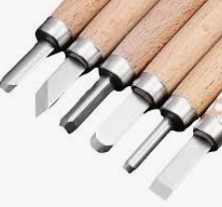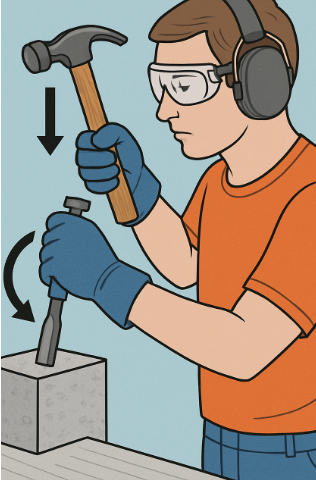In various industrial and craft fields such as metalworking, woodworking carving, and stone trimming, the steel chisel remains an indispensable core hand tool. With modern manufacturing demanding higher precision, durability, and user safety, the material selection, design structure, usage methods, and daily maintenance of chisels have become popular topics of ongoing industry focus.
Comparison of Steel Chisel Materials: High Carbon Steel vs. Alloy Steel

The core performance of chisels lies in the choice of steel material. Currently, the mainstream materials are high carbon steel and alloy steel. Each has its own advantages and disadvantages and is suitable for different applications.
| Feature |
High Carbon Steel |
Alloy Steel |
| Hardness |
Relatively high, suitable for fine carving |
Extremely high, strong impact resistance |
| Toughness |
Brittle, prone to chipping |
More durable, suitable for heavy impact work |
| Suitable Field |
Woodworking, fine stone carving |
Metalworking, construction chiseling |
| Maintenance |
Requires frequent sharpening |
Wear-resistant, longer maintenance cycle |
Suggestions:
1.Woodworking/Carving: High carbon steel is sharper and better for detailed work.
2.Metal/Stonework: Alloy steel offers strong impact resistance, suitable for high-intensity tasks.
Electric vs Manual Steel Chisels: Balancing Efficiency and Precision
With technological progress, electric chisels are becoming more common, but manual tools remain irreplaceable. Below is a key comparison:
1.Electric Steel Chisels
Advantages: High efficiency, suitable for batch operations (e.g., concrete grooving, metal cutting).
Disadvantages: Noisy, reliant on power supply, less precise.
2.Manual Steel Chisels
Advantages: Precise control, ideal for fine carving and working in tight spaces.
Disadvantages: Requires physical effort, can cause fatigue with prolonged use.
3.Usage Recommendations:
Industrial settings: Electric tools improve efficiency.
Artistic creation/repairs: Manual tools offer more flexibility.
Operational Safety: Often Overlooked Hazards
Common mistakes in chisel operation and safety guidelines to follow:
Common Mistakes:
Incorrect hammering angle: Can cause chisel blade breakage or flying debris injuries.
Continuing to use a dull blade: Increases risk of slipping and operational injuries.
Holding the handle with bare hands: Loss of control due to vibration or slipping raises injury risk.
Safety Recommendations:

1.Check the chisel blade for any damage or hairline cracks before use.
2.Always wear safety goggles and gloves.
3.Secure the workpiece firmly; avoid holding the chisel by hand while chiseling.
4.Use an appropriate hammering force to prevent chisel breakage caused by excessive impact.
Three Key Maintenance Tips to Extend Tool Life
The lifespan of a high-quality chisel depends not only on the material and manufacturing precision but also on whether the user performs proper maintenance. The following are three widely recognized maintenance tips in the industry:
1.Proper Sharpening
Regularly sharpen using a sharpening stone or grinding wheel.
Maintain the original bevel angle, generally between 25° and 30°.
Remove burrs from the edge to prevent the chisel from “biting” or catching unexpectedly.
2.Rust and Moisture Protection
Wipe dry immediately after use and apply anti-rust oil.
Store in a dry place, avoiding contact with cement, acids, or alkaline environments.
3.Organized Storage
Store chisels separately according to use for woodworking, metalworking, or stonework.
Use blade covers or chisel cases to prevent collisions and protect the edges from damage.
Industry Trends: Future Development Directions of Chisel Technology
With the continuous upgrade of the manufacturing and DIY markets, the chisel industry is entering a critical period of technological transformation. In the coming years, chisels are expected to achieve breakthroughs in three major areas: materials science, intelligent applications, and eco-friendly production. These innovations aim to meet the demands of efficiency, precision, and sustainability in modern industries. Below is an in-depth analysis of the future trends:
1. Application of Composite Materials: Coating Technology and Extreme Wear Resistance
Traditional chisels are limited by the physical properties of steel, often experiencing wear and edge rolling under prolonged, intense use. In the future, through composite material technologies, the durability and adaptability of chisels will be greatly improved:
(1) Titanium Coating Technology
Advantages: Titanium has high hardness and corrosion resistance. By applying a PVD (Physical Vapor Deposition) coating to the chisel surface, friction is significantly reduced, extending the tool's lifespan.
Applications: Ideal for high-wear tasks such as concrete chiseling and metal cutting; expected lifespan increase of over 3 times.
(2) Tungsten Carbide Edge Reinforcement
Tungsten carbide particles are fused onto the chisel edge, raising local hardness to over HRC90 (much higher than standard alloy steel at HRC60). This is particularly suitable for processing ultra-hard materials such as granite and cast iron.
(3) Gradient Material Structure
Using heat treatment and laser cladding technologies, a layered "hard-outside, tough-inside" structure can be achieved—a high-hardness, wear-resistant surface combined with a tough core to prevent breakage.
2. Intelligent Advancements: Giving Traditional Tools "Perception"
The growing adoption of electric chisels marks only the beginning of tool smartification. Next-generation chisels will be revolutionized through IoT (Internet of Things) and sensor technologies:
(1) Overload Protection System
Pressure sensors embedded in electric chisels detect abnormal resistance and automatically shut off power to prevent motor burnout or chisel tip breakage.
Typical Scenario: While chiseling rebar, if the tool jams, the system stops output within 0.1 seconds.
(2) Operational Data Logging
With accelerometers and gyroscopes, tools can record:
Impact force distribution per strike
Cumulative workload statistics
Edge wear predictions
Data can be transmitted via Bluetooth to a mobile app, generating maintenance reminder reports.
(3) Adaptive Power Adjustment
Automatically adjusts impact frequency based on material hardness:
Softwood carving: 2000 strikes/minute in low-frequency, high-precision mode
Concrete demolition: 4500 strikes/minute in high-frequency, high-power mode
3. Eco-Friendly Design: Green Innovation Across the Product Lifecycle
Driven by carbon neutrality goals, the chisel industry is building an environmental protection system across three dimensions:
(1) Use of Recyclable Steel
Electric arc furnace smelting using scrap steel reduces carbon emissions by 75% compared to traditional methods.
Example: chisels made from recycled car body panels achieve 98% performance of virgin steel.
(2) Low-Carbon Manufacturing Processes
Green heat treatment: Induction heating replaces coal furnaces, cutting energy use by 40%
Water-free cutting fluids: Use of biodegradable lubricants with dry machining techniques
(3) Long-Life Product Design
Modular structure: Allows for individual chisel head replacement, reducing full-tool waste
Remanufacturing services: Old chisels collected and refurbished, with core components reused at a rate of up to 80%
Carbon Footprint Comparison of Eco Chisels (Unit: kg CO2 per chisel)
| Production Stage |
Traditional Process |
Green Process |
| Raw Material Extraction |
3.2 |
0.8 |
| Heat Treatment1 |
1.5 |
0.9 |
| Transport & Packaging |
0.7 |
0.3 |
| Total |
5.4 |
2.0 |
Details Define Professionalism
In today's market, a chisel is no longer just a simple hand tool—it is a symbol of craftsmanship and industrial efficiency. From material selection and usage methods to maintenance, every step reflects professional standards and manufacturing intelligence. With the advancement of eco-friendly materials, new processing technologies, and smart tool interfaces, future chisels will be lighter, more durable, and safer. The development of the industry relies on attention to detail and continuous optimization.









